
|
The Jedi were real? This article is part of the history of Clan Odan-Urr and isn't part of current events.
Please do not remove this tag or the contents. These articles exist for historic purposes.
|
Iwu Koraha Mahue is the name for a gathering of several hundred tribes in the Central Desert region of the Milil’ea continent on Harakoa. It is a loose conglomerate of merchants, miners, nomads and warriors that live as separate communities bonded by tradition and history. Iwu Koraha Mahue is loosely translated as People of the forgotten desert. Councillor V'yr Vorsa considers herself toiora, "one of the people", and is their representative on the Jedi Council and the government of Meant Ombo.
History
Prehistory/Antiquity
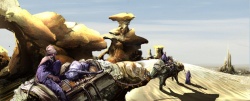 Nomad merchants
Nomad merchants
The Harakoans of the Central Desert never truly migrated to that region, as it was initially believed. Some nine to twelve thousand years before current events, the whole desert was a lush grassy plain, dotted by rocky hills. Archeological finds in the layered dirt indicated a gradual climate shift over the millenia as the mountains grew larger and blocked the favorable moist air escaping Owyhyee,l. The region slowly turned into savanna and gradually, and very slowly into an arid desert with only rare fauna sell.
Why they stayed is still a mystery, but some Jedi archeologists believe it is due to their sacred ritual site, Rauru Pae, which appears to have been the same thousands of years ago.
Last Centuries
It is known from oral tradition and scarce artifats, that their current tribal system developed many centuries ago. Scarce resources seemed to band groups of natives together into large families and tribes through necessity which created friendly and iften familial relations with other similar groups. After centuries the tribes of the Korahaii bonded into a single large alliance which recognizes every tribal leader and tribe as independent. When exactly this occurence happened remains unknown but tradition states that after a long conflict between the tribes, all the chiefs gathered under one tent and agreed to share all that they owned. This theory is highly unlikely and often dismissed as traditional story telling and embellishment. It is more likely that the tribes gradually moved towards a symbiotic lifestyle over the centuries, due to the lack of resources.
Another theory seems to have take root with some of the Jedi Archeologists in recent years. It states that during the centuries before the unification, one or more of the many tribes discovered a way to mine and process copper, giving them a significant advantage both in cultural, technological and economic growth. Due to the jump in technology, these tribes took a leadership role and gradually subjugated the others under their rule. As time passed by and leaders changed, the bond that held them together loosened and what was left was the current order of unified but independent singular tribes lead by a "council" of chieftains. This theory is being researched still but is gradually being accepted as more evidence is uncovered.
After arrival of Jedi
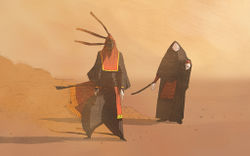 Korahaii nomads
Korahaii nomads
It was only after the re-taking of Harakoa after the Thuronian conflicts that these tribes were truly investigated in depth. Though several prior reports indicated that Harakoans did live in the Central Desert, none of them had the research and material needed to expand beyond the obvious. It was Jedi Councillor V'yr Vorsa who found the tribes fascinating and note-worthy, due to their resilience to the burning heat and dry desert conditions. She and her team of bith civilian and Jedi scholars began a gradual acclimatization with several tribes in hopes of exploring their culture.
After the formation of the Korahaii militia as part of the K.U.D.F., Vorsa was also named "Toiora Mokai'Taika", loosely translated to "Roaring Mōkaikai Mother", reflecting her military prowess, leadership and relationship towards her warriors. The warriors of the Korahaii call her "Toiora", meaning "Mother", which is considered an honorable and respected name in their circle. Vorsa lived with the Korahaii for a long while, before returning to her Clan duties, becoming one of Matua's tribe in a very short time. She considers herself part of their family and often travels to the desert to spend time with them and live a simple life away from the hustle and bustle of the galaxy.
Geography
The vast desert expanse holds many danges for the unwary traveler and contains as many different terrains as it does species of flora and fauna. The north of the region is covered in unending sand dunes, liquid sand and deadly sandstorms. Freak tornadoes and dust devils are frequent. Most natives avoid these areas, though with the right equipment one might survive long enough to traverse the expanse and find shelter in the mountains.
The south of the desert is mostly rocky, though still covered with sand carried from the north. On the eastern slopes of the mountains, a vast expanse of natural geysers spewing large quantities of heglum gas. These natural phenomena occurred due to tectonic activity deep beneath the mountains. The tribes use these gasses to lift their flying dirigibles and traverse the rocky crevasses around the feet of the mountains. Most of the Korahaii live in the arid wastes of the south, protected from the deadly sandstorms.
Climate
The climate of this region is uncomfortably hot and arid, and at times blistering. Though the tribes of the desert have grown accustomed to it, most travelers and visitors tend to endure many health problems. Acclimatization to the weather is hard and long, but once acclimated, one can travel the desert with little fear of the elements. However, all travelers nomad or foreign are required to wear clothes that completely cover their bodies. The blistering heat and the intensity of Yhi against the glassy surface of the desert tends to create painful blisters and burns on the skin, especially on fairer skinned species, like humans. For this purpose and many more, the Korahaii wear thick insulating clothing and face masks when traveling.
During the day temperatures skyrocket to 55 degrees standard, while during the night they can plummet below freezing. Winds are a major obstacle while traveling in the northern desert, since freak tornadoes and dust devils are frequent. Sand storms are a true hazard and the only reason why the northern parts of the desert are never permanently settled.
Biome
 Nomad traveling on a Mōkaikai
Nomad traveling on a Mōkaikai
Anything and everything that lives in the desert is both very adaptable and water-conserving. Many plants that live in the desert proper have natural mechanisms for gathering moisture and conserving it, much like the moisture-gatherers of Tatooine. Travelers use these plants to replenish their water supply. Other plants live near watering holes, creating lush green dots on a very barren landscape. These watering holes are plentiful, though often dried out in the summer months. There are several rivers flowing from the mountains into the vast underground caverns and crevices below the desert. They fill what natural wells dot the landscape. These, however, must be discovered and re-discovered every year, due to the shifting environment and frequent cave-ins.
Mōkaikai
Many animals that live in the desert aren't bigger than a common pet, but some like the Mōkaikai, a creature similar to the Tatooinian Dewback, live and thrive in this environment. The Mōkaikai is a cold-blooded lizard about the size of a small riding horse, and just as easily domesticated and non aggressive unless provoked. It's padded feet make it ideal for traversing the scorching sands. These lizards have a natural mechanism for gathering moisture from the air at night, which gives them an abundant amount of water to continue functioning during the day.
Mainly slow to conserve energy and water, these lizards posses enviable endurance and stamina. Even so, they are known for their speed when in trouble and often spew black ichor at any attackers before dashing away and hiding under the sands. They eat small rodents and desert flora found in abundance around watering holes and oases. They are mostly kept as house pets and beasts of burden by the Korahaii.
Territory
The tribes cover a wide area of the desert. Except for their trading outposts which often turn into small mobile towns, they have no permanent residence, though ancient ruins have been found under the dunes. These are being meticulously excavated by Jedi and civilian academic alike and are believed to be part of the ancient Maia'toan ruin system that spans the planet.
The Korahaii are mostly nomads who travel with the seasons and in search for tradeable goods and food. Their territory is at times as small as the Colonies on Owyhyee or as big as the whole Central Desert. Traveling across this vast expanse, between sparse watering holes, oases and wells requires ingenuity and skill. The Korahaii utilize several different animals for their travelling needs, but most of all they utilize the Mōkaikai lizards who can be found in abundance in the rockier parts of the desert.
Dirigibles
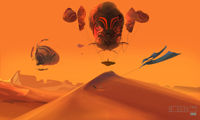 Hanu-matai dirigibles
Hanu-matai dirigibles
The Korahaii have used another type of transport for generations. On the western slopes of the mountains, massive geysers constantly spew heglum gas which the tribes have learned to harness for their own use. They stitch Mōkaikai skins into bags hundreds of cubic meters in volume. Filling these bags with gas, gives them lift which they then use to cross the desert. Travelling with these contraptions is only possible in the western and southern regions of the desert where the rocky terrain protects the tribesmen from harsh winds and deadly sand storms. The dirigibles, or Hanu-matai as the Korahaii call them, are only useful for singular trips between trading posts as the have to be refilled. They are very slow, but steady, and travel easily with a favorable wind.
They usually float several meters from the ground, weighed down with sandbags and pushed forward with long wooden rods on both sides. These rods are the only type of steering the dirigibles have. The Matai caravans form every harvest season around the Papaaee geyser fields and travel south towards Towori Wae, the Harakoan trading post on the southern edge of the desert.
Inamata Toma
 Inamata Toma
Inamata Toma
Inamata Toma is an ancient Harakose name for the ruins of a civilization that pre-dates the current tribes by several millennia. It roughly translates to Ancient tombs. Located in the Western desert, near the massive mountain ranges, it is a mystery still being uncovered by Jedi archeologists. Many artifacts were dug out of the ruins, confirming the notion that copper and bronze were used on Milil’ea long before the Korahaii discovered them.
The ruins are made from rough limestone, but it is believed the outer surfaces were covered by a more polished white limestone found in the mountains. While they are monumental structures, the millennia of rough winds and desert sands have reduced them to near-indistinguishable stone formations. It is highly speculated that these ruins are in fact Maia'toan in origin, and that civilizations succeeding the ancient mysterious Harakoans have made it their home for centuries. Though they stand today as only ruins, it is speculated that once they spanned the vast plains of Milil'ea as massive cities, which is a debatable theory, but matches well with the finds in Owyhyee and Sanulu.
Towori Wae
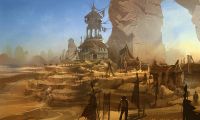 Towori Wae trading outpost
Towori Wae trading outpost
Towori Wae (bas. Last town) is a native name for a trading outpost which stands on the banks of the Tatamai river just north of New Varri'alis. It was established by the tribes that wish to have little or no contact with the foreigners in the city. Here they trade goods with alien-friendly Korahaii who ship those goods to the city and further. The small town is a rag tag setting of various sandstone houses, mobile shelters and animal farms. It is dominated by a large tower that shines a light at night for any weary travelers to use as a point of reference.
The town itself has evolved from a small community into a fairly large and busy gathering of various tribes and individuals. Foreigners hold shops here as well, trading with the less xenophobic natives whenever possible. There is also a very prevalent black market in Towori Wae that local Marshalls have become weary of. Many illegal energy weapons have found their way into the hands of the natives, prompting minor incidents that could escalate in the future.
Travelers traversing the desert will find refuge in the town as well as transport in the form of dirigibles and mounts. May tourists find it to be the last outpost before braving the vast expanse of the desert beyond.
New Varri'alis
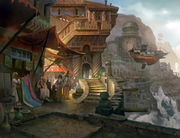 New Varri'alis
New Varri'alis
Situated on the southern coast of Milil'ea, New Varri'alis is booming port city built in a short two years from a simple dockside trading hub into the largest city on the continent. Situated in a natural bay and overlooking the Bythic ocean, the city is built in and around the massive cliffs that dominate the coastline.
TBA
Structure
Each tribe of the Korahaii people have their own priests and chief. Though they are all essentially the same people, their traditions and places of worship may vary from tribe to tribe. Chiefs are often the wiser and older members of the tribes, the ones who have lived a lifetime in the desert and know it's nooks and crannies well.
Chieftain
It is the duty of the chief of each tribe to advise his people, plan travel routes, manage the tight schedule and keep everyone "on the same track", as it were. They are not so much an authoritarian position as one of coordination. Most chiefs are considered to be fathers to their people, thus the name Matua which in ancient Harakose means chief, or father.
Tā-Raumati Matua (which loosely translates to Chief Summer-Wind, or just Summer-Wind) is the eldest and wisest of the chiefs, acting more as an adviser to his younger compatriots, rather than being an actual king or leader.
Military
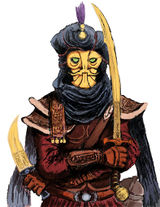 Korahaii Chosen
Korahaii Chosen
The Korahaii have a proud warrior tradition even though full scale wars are rare. All of the weapons that the Korahaii use are bronze. The more decorated the weapon the higher one's status or wealth. Some weapons are known to be passed through the generations as family heirlooms as well.
Tribal wars are very rare, but when they do occur, they are either negotiated or resolved through single combat much like smaller disputes. It is very rare for whole tribes to go to war, but it has occurred in the past and may occur in the future as well.
The tribes offer their best warriors - all volunteers or widowers - to the KUDF for advanced training. They are taught to use modern blasters and armor, as well as modern strategies by the bets instructors the Clan can offer. The Korahaii Chosen, as they are called, have since learned to disassemble, modify and remake their own versions of blasters and modern weaponry. While they use machined internal parts, they often detail their weapons with intricate brass filigree and wooden stocks and handles. These weapons are hand-made works of art as much as tools of destruction.
Law
Most crimes are punishable by community service or downright servitude for a period of time dictated by the chief. Local and domestic conflicts and bigger crimes are handled through ritualized single combat. Though it was once lethal, these days most chief have banned killings in duels due to the need for able hands. Some still hold to old traditions, however.
Religion
 Rauru-Pae
Rauru-Pae
The Korahaii ritualize and revere almost any creature they come upon in the desert and have a deep sense of belonging to the environment. The desert is their Ūkaipō, their Mother, and she provides or takes from them as she sees fit.
All Korahaii, regardless of tribe, have one specific place where they gather to give thanks to the desert for another year of their lives. It is called Rauru-Pae, or Mother's place, and it consists of a rocky hill on top of which the Korahaii of old have built altars and places of worship. Most priests lead their tribes on month-long journeys to Rauru-Pae so that all may give praise to their Mother.
Priests
Priests have no worldly powers, but they have a lot of influence on the people as their religious paragon. Priests often work with the chiefs to maintain order and discipline in the tribes. They are also well versed in medicines and poisons. They possess great knowledge about the flora and fauna of the desert and are considered great survivalists.
Commerce
Most commerce in the desert revolves around food, bronze, fine cloth and similar goods. The tribes trade with other Harakoans on the continent and receive wheat, wine, fruits, fish and other goods not readily available in the desert. The food trade consists of trading Mōkaikai meat, which is abundant, hardy, long-lasting and good with cheese.
Culture
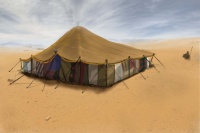 A traditional Korahaii tent
A traditional Korahaii tent
Languages
While the Korahaii do speak Harakose, they do so in an ancient dialect very different from the ones the Jedi are used to. Understanding them is hard at best, and often requires hours and hours of study to master their language. This dialect is their trading language, used mostly for communication with other tribes in the region. However, they do use their own language while in the confines of their tents. This language still remains a mystery and will have to be studied further.
Music
Music is often the distraction of choice among the Korahaii. They sing and dance mostly during the night when they spend quality time with their family and friends. The instruments used are mostly string or drums made from animal leather and bones, however they have a peculiar sound not heard anywhere else. Music is also part of their rituals, both combat and religious.
Art
The Korahaii express their taste for art through their colorful clothing, weaponsmithing and their demeanor towards strangers. They consider hospitality a certain art form and have ritualized the process of smoking, drinking and even eating with strangers to a fine point. The weapons they use are labors of love and are often decorated with lavish designs to signify the wearer's importance. The same goes for clothes. The Korahaii have a love for fine and colorful clothing and often wear lavishly designed masks to cover their faces from the brutal winds and heat of the desert.
Foreign Relations
Tythonians
So far no communication between the tribes and the Tythonians took place. The Korahaii receive their outside information from the Jedi who chose to stay with them.
House Odan-Urr
Apart from several Jedi archeologists and the ambassador, most Jedi focus on other endeavors and care little about the desert tribes. Tā-Raumati Matua, as the representative, has met with Councillor Torun on several occasions, mostly to broker trade deals. Slowly but surely the tribes are being acclimated to the notion of outside influence and are befriending the Jedi.